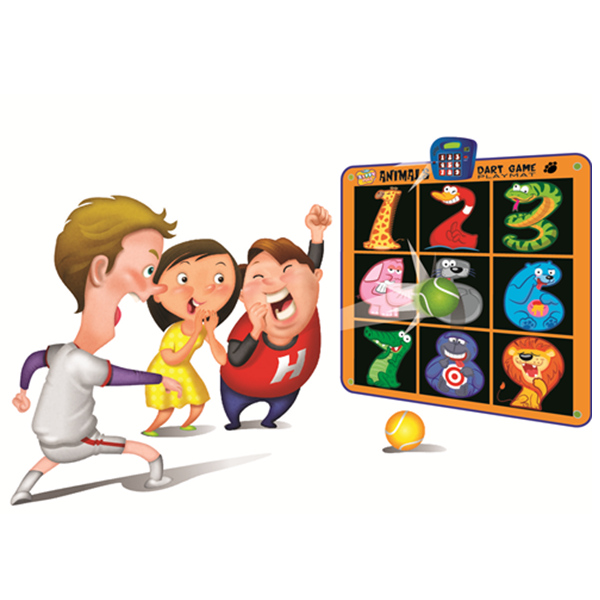What is the developing direction of toys in the digital age?
Toys are not only a window for children to see the world, they also reflect the economic level, children's culture, aesthetic orientation as well as scientific and technological progress of a certain time. Exploring the changes of children's toys can let us better understand the value of toys for children's development.
The close connection between childhood and toys determines that childhood memories of people in different ages are branded with different toy memories.
In the 1950s and 1960s, China was struggling in solving the problem of food and clothing. For children at that time, there were few toys on the market, so they decided to make their own toys, among which wooden toys are the most common, such as wooden pistols, gyros, small tricycles and slingshots, as well as clay toys, sound toys, etc. Besides, hoops, shuttlecocks, glass marbles were also very popular among children at the time.
In the 1970s, tin-plate toys began to flourish and gradually took away the popularity of wooden toys among children, the most representative toys at the time in China were wind-up frogs, tin-plate trains, tin-plate robots, etc.
In the 1980s, Transformers and consoles (NES, and Chinese knockoff "Xiaobawang" Learning Machine) started to prevail, along with Rubik's cubes, building blocks, Barbie dolls, Tamagotchi, mini 4WD, etc.
In the 1990s, a large number of foreign animations got into China, and the children's toy market in China has been rapidly occupied by animation characters from G.I.JOE, Toy Story, Ninja Turtles, Doraemon, etc.
Since the beginning of the 21st century, as the rapid spread of electronic technology, iPad, Sony PSP, PS Vita, Nintendo 3DS, Switch, remote control toys and so on have become children's favorites. At the same time, foreign animation related toys also ushered in a heyday.
Since the second half of the last century, the historical changes of children's toys among different generations in China have truly interpreted the transformation of children's culture.
The quality of children's toys changes with technology
From the historical changes of children's toys since the founding of New China, it can be seen that modern children's toys have also metamorphosed with the development of science and technology.
The first is commercialization. Traditional toys are mostly made from natural materials in the surrounding environment and scraps in life, by the hands of children and parents. While modern children's toys are mass-produced based on industrialized mold design and mechanization technology, which is standardized and unified in structure and function, widely supplied in the form of commodities. In the background of fast-paced modern life, direct purchase becomes a convenient channel for obtaining toys.
Another two changes are electronization and intelligentization. Based on the rapid development and promotion of digital technology, the design and development of modern children's toys are gradually integrated with electronic technology and intelligentized characteristics. Compared with the simplicity, nature of traditional toys, modern toys stimulate and attract children by their novelty in a form of the synchronization of sound, light, and shadow. Today, it can be seen everywhere that a child is concentrating on an electronic screen. Video games also reflect the increasingly widespread and profound promotion and penetration of high technology in recreation.
Next, there are fashion and Westernization. Compared with traditional toys, which inherit native culture and ethnic customs in the production process, today, children's toys show more admiration to animation characters and western culture. Meanwhile, with the broadcast and boost of animations for children, various kinds of toys are constantly being updated. This shows that the market of children's toys follows the fast-food style orientation of faddism.
The change of value
In the great progress of modern children's toys, there are hidden changes in value that are closely related to the development of young children.
First, the market attaches more importance to function than emotion. The popularity of modern commoditized toys and electronic toys dilutes the parent-child interaction and the peer relationship established by traditional homemade toys. Children are interested in exploring the virtual worlds and making conversation with virtual characters, which replace the need and desire for the interpersonal relationships and emotions in reality. At the same time, because there is no need to use natural materials, as well as gaming being an indoor activity, and the oversoon academic pressure, children nowadays have less time for outdoor activities.
Second, many modern toys are with advanced technology but instill scanty cultural heritage. Traditional handmade toys carry long national culture and historical traditions. However, with modern high-tech toys and video games gradually become the new entertainment of children, traditional toys and games are fading out of the life of children.
The assembly line and mass production of modern toys weaken the bond among children and adults formed by handmade toys. In kindergarten and family education, it is necessary to construct communities with toys making and playing where children, parents, teachers can feel the joy of discussion, exploration, cooperation and sharing.
In order to fully protect the physical and mental health as well as the development of children, a screening mechanism for the toy market should be established. In general, choosing toys for children have several requirements: In terms of function, toys need to encourage children to think, create, meet their desire to explore and express, and to help them obtain useful knowledge and activity experience; In terms of play, toys should be suitable for children's age, characteristics and level. For materials, toys have to be safe, durable, eco-friendly. Manufacturers should ensure that there is no sharp corner, odor, pollution and radiation. It is better that the toys are easy to clean and reusable. The style of toys needs to meet the requirements of aesthetics: vivid shape, bright color, etc.

The close connection between childhood and toys determines that childhood memories of people in different ages are branded with different toy memories.
In the 1950s and 1960s, China was struggling in solving the problem of food and clothing. For children at that time, there were few toys on the market, so they decided to make their own toys, among which wooden toys are the most common, such as wooden pistols, gyros, small tricycles and slingshots, as well as clay toys, sound toys, etc. Besides, hoops, shuttlecocks, glass marbles were also very popular among children at the time.
In the 1970s, tin-plate toys began to flourish and gradually took away the popularity of wooden toys among children, the most representative toys at the time in China were wind-up frogs, tin-plate trains, tin-plate robots, etc.
In the 1980s, Transformers and consoles (NES, and Chinese knockoff "Xiaobawang" Learning Machine) started to prevail, along with Rubik's cubes, building blocks, Barbie dolls, Tamagotchi, mini 4WD, etc.
In the 1990s, a large number of foreign animations got into China, and the children's toy market in China has been rapidly occupied by animation characters from G.I.JOE, Toy Story, Ninja Turtles, Doraemon, etc.
Since the beginning of the 21st century, as the rapid spread of electronic technology, iPad, Sony PSP, PS Vita, Nintendo 3DS, Switch, remote control toys and so on have become children's favorites. At the same time, foreign animation related toys also ushered in a heyday.
Since the second half of the last century, the historical changes of children's toys among different generations in China have truly interpreted the transformation of children's culture.
The quality of children's toys changes with technology
From the historical changes of children's toys since the founding of New China, it can be seen that modern children's toys have also metamorphosed with the development of science and technology.
The first is commercialization. Traditional toys are mostly made from natural materials in the surrounding environment and scraps in life, by the hands of children and parents. While modern children's toys are mass-produced based on industrialized mold design and mechanization technology, which is standardized and unified in structure and function, widely supplied in the form of commodities. In the background of fast-paced modern life, direct purchase becomes a convenient channel for obtaining toys.
Another two changes are electronization and intelligentization. Based on the rapid development and promotion of digital technology, the design and development of modern children's toys are gradually integrated with electronic technology and intelligentized characteristics. Compared with the simplicity, nature of traditional toys, modern toys stimulate and attract children by their novelty in a form of the synchronization of sound, light, and shadow. Today, it can be seen everywhere that a child is concentrating on an electronic screen. Video games also reflect the increasingly widespread and profound promotion and penetration of high technology in recreation.
Next, there are fashion and Westernization. Compared with traditional toys, which inherit native culture and ethnic customs in the production process, today, children's toys show more admiration to animation characters and western culture. Meanwhile, with the broadcast and boost of animations for children, various kinds of toys are constantly being updated. This shows that the market of children's toys follows the fast-food style orientation of faddism.
The change of value
In the great progress of modern children's toys, there are hidden changes in value that are closely related to the development of young children.
First, the market attaches more importance to function than emotion. The popularity of modern commoditized toys and electronic toys dilutes the parent-child interaction and the peer relationship established by traditional homemade toys. Children are interested in exploring the virtual worlds and making conversation with virtual characters, which replace the need and desire for the interpersonal relationships and emotions in reality. At the same time, because there is no need to use natural materials, as well as gaming being an indoor activity, and the oversoon academic pressure, children nowadays have less time for outdoor activities.
Second, many modern toys are with advanced technology but instill scanty cultural heritage. Traditional handmade toys carry long national culture and historical traditions. However, with modern high-tech toys and video games gradually become the new entertainment of children, traditional toys and games are fading out of the life of children.
The assembly line and mass production of modern toys weaken the bond among children and adults formed by handmade toys. In kindergarten and family education, it is necessary to construct communities with toys making and playing where children, parents, teachers can feel the joy of discussion, exploration, cooperation and sharing.
In order to fully protect the physical and mental health as well as the development of children, a screening mechanism for the toy market should be established. In general, choosing toys for children have several requirements: In terms of function, toys need to encourage children to think, create, meet their desire to explore and express, and to help them obtain useful knowledge and activity experience; In terms of play, toys should be suitable for children's age, characteristics and level. For materials, toys have to be safe, durable, eco-friendly. Manufacturers should ensure that there is no sharp corner, odor, pollution and radiation. It is better that the toys are easy to clean and reusable. The style of toys needs to meet the requirements of aesthetics: vivid shape, bright color, etc.

Related News
- Perfect Electronic Playmats for Children with Different Constellations (Part Four)
- Perfect Electronic Playmats for Children with Different Constellations (Part Three)
- Perfect Electronic Playmats for Children with Different Constellations (Part Two)
- Perfect Electronic Playmats for Children with Different Constellations (Part One)
- Four Musical Toys to Foster Baby's Music and Hearing Ability
- Three steps to organize toys and spare space for kids to play
- Three principles that keep your kids away from dangerous toys
- How to teach a kid to share toys with others (part two)
- How to teach a kid to share toys with others (part one)
- How to get children to tidy up toys
